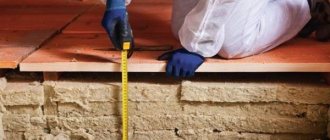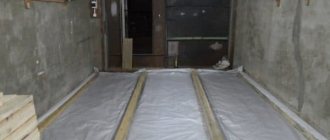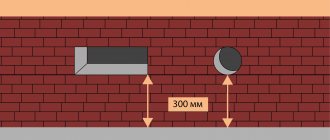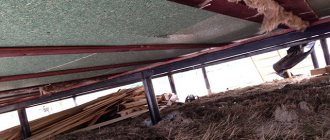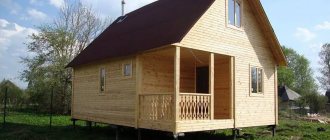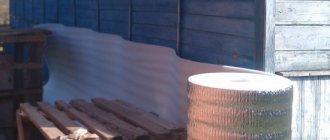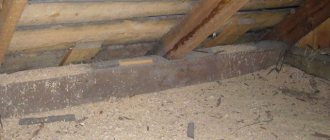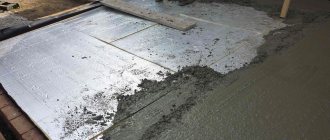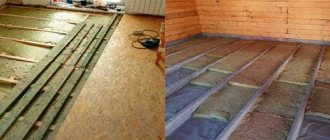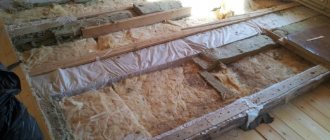As in the old days, floor insulation with sawdust has gained serious popularity. This material is very accessible and cheap, since it is the main woodworking waste. At any sawmill they will be given away for free, or at least for a nominal fee. In addition, sawdust has good thermal insulation characteristics. But sawdust is different from sawdust, so you need to know how to choose them correctly so that the insulation is as effective as possible.
What can and cannot be insulated with sawdust?
To ensure the most comfortable living conditions in the building, it is necessary to take care of the insulation of the following structures:
- floor on the ground in buildings with a warm basement or basement;
- ceiling over a cold basement or underground;
- exterior walls;
- covering the upper floor when designing a cold attic or technical floor;
- covering in the absence of an attic;
- pitched roofs when arranging an attic.
Since sawdust is a bulk material, it is almost impossible to use it to insulate walls or pitched roofs. They are best suited for increasing the heat-insulating characteristics of the attic floor and the floor above the cold underground .
Nowadays, although there is a large assortment of thermal insulation materials on the construction market, sawdust is not widely used. Most often, they are chosen by those owners who prefer to use completely natural and environmentally friendly materials in construction.
Why is insulation necessary?
The thickness of the wooden floor in a house does not always meet the requirements of heating engineering.
Making it thicker is not economically profitable, so they resort to various heat-insulating materials. The future owner of the house is faced with a choice: whether to take into account the requirements for thermal protection or take into account only the strength of the structures. Timely measures taken to insulate the floor allow you to avoid the following troubles in a wooden house:
- excessive heating costs;
- cold floors;
- condensation from the warm air, resulting in wood rotting and the appearance of fungus and mold.
Carrying out additional measures during construction will avoid high operating costs and the need for frequent repairs.
Advantages and disadvantages of sawdust as insulation
A sufficient number of positive characteristics allowed sawdust to become famous:
- low thermal conductivity and high degree of protection of the structure from freezing;
- availability of the material and its low cost (at some sawmills they are willing to give away sawdust for free);
- environmental safety and naturalness;
- the ability to carry out insulation work with your own hands.
When using sawdust, you should remember their negative qualities and features:
- any wood dries out over time, and the percentage of volume reduction in sawdust is quite high;
- susceptibility to rotting;
- the occurrence of mold;
- sawdust is an excellent habitat for various microorganisms, insects and rats.
These shortcomings are not inevitable. They can be eliminated by using sawdust in tandem with other materials. as protective additives to sawdust:
- clay;
- lime;
- cement;
- boric acid (antiseptic).
In this case, the mixture will not be susceptible to the appearance of fungus and the appearance of various living creatures.
Advice from professionals
- In no case should you violate fire safety requirements, for example, use dry sawdust mixtures or cement-sawdust compositions in places where the floor can become very hot.
- A natural and inevitable process is sawdust shrinkage, so after a couple of years you need to check its level and, if necessary, add insulation.
- Fresh sawdust is poorly wetted with water, so you need to choose ones that have been sitting for several months, or you will have to add liquid glass to the water.
- In terms of technical and practical qualities, only mineral wool can be compared with sawdust. Their consumption is the same, but sawdust is much cheaper and cleaner in terms of the environment.
- It is advisable to install thermal insulation in the warm season, since it is easier to dry the mixture or clean sawdust.
- It is better to use pine sawdust, since the resin it contains repels beetles better than others.
- If the bathhouse is being insulated, then the sawdust here cannot be soaked in poisonous copper sulfate, which, when heated, will enter the atmosphere of the building.
It is beneficial to use sawdust as insulation from both an environmental and economic point of view. They can insulate not only the floor, but also the walls and the roof. They are easily transported, mixed with a variety of additives and have a long shelf life.
Would you decide to insulate the floor with sawdust? Explain your yes or no answer in the comments - it is important for us to know your opinion.
Floor pie during insulation
Insulation is not the only component of proper thermal protection of a structure. Sawdust requires preventing water and steam from getting on it, so waterproofing and vapor barrier will become additional layers. It is very important not to confuse their location, otherwise all insulation work will be pointless.
Insulating an attic with sawdust will require laying the components in the following order from bottom to top:
- floor design;
- vapor barrier;
- sawdust;
- waterproofing;
- attic floor.
Scheme for insulating an attic floor
When insulating the floor above a cold underground, the layers are arranged in a different order:
- floor design;
- waterproofing;
- sawdust;
- vapor barrier;
- first floor floor.
Scheme of floor insulation above a cold underground
Sometimes it is said that it does not make much difference which side the vapor barrier is laid on, but this is not true. Steam can penetrate into the insulation only from the side of warm air, so it is logical to install protection against it inside the heated room. Waterproofing, on the contrary, protects against condensation that falls from the cold air onto a warmer surface. Failure to comply with these rules will lead to disastrous consequences for the insulation and it will cease to perform its functions.
Which sawdust to choose
Going into the forest to cut down a tree and use it for sawdust is not the best option. There are many other ways that cause minimal harm to nature and are more intelligent. Sawdust obtained during carpentry is ideal for insulation. This material has good moisture content and is less susceptible to damage by mold, mildew and insects.
Sawdust is available in large quantities at sawmills. They are waste of wood that has not yet dried, so their characteristics are worse than those of the previous ones. But such material can also be used to insulate the floor in a wooden house.
It is best to choose small chips. They will be able to provide the most effective thermal insulation.
Preparing to start work
Before laying the insulation, you need to determine its thickness. This value depends on the construction area. In a wooden house that is used all year round, the thickness of sawdust for the floor will be approximately 30 cm. After this, it is better to calculate the exact volume of necessary materials so as not to encounter difficulties during the construction process.
For insulation work you will need:
- sawdust;
- lime;
- cement or clay;
- wood antiseptic (for example, boric acid);
- container for diluting the mixture;
- kneading spatula;
- watering can for spraying the finished mixture with boric acid.
Types of sawdust composition
The material is considered the most environmentally friendly and at the same time has a low cost.
Sawdust is recycled wood. The appearance depends on many indicators: sawing, planing, drilling:
- Fine dust is obtained from wood processing by sawing;
- Chips – planing or drilling waste, 3-5 cm in size;
- The sawdust fraction also depends on the method of wood processing; material with a fraction of 0.5 to 3 cm is commercially available.
The material is considered the most environmentally friendly and at the same time has a low cost. In addition, sawdust weighs a little and has excellent heat and sound insulation qualities. Hardwood waste is indicated for use: pine, spruce, ash, oak.
Work order
Sectional diagram of floor insulation
For ease of understanding, all the necessary steps are presented point by point:
- Installation of cranial bars [2] from the side surface of the joist. The cross section is recommended to be no more than 30 by 40 mm.
- Laying on cranial bars [3] made of third grade boards or plywood sheets. The material is not secured.
- Laying waterproofing material [4] , which can be an ordinary polyethylene film. It is secured to the joists using nails with wide heads.
- After this, sawdust [5] is poured or a sawdust-cement (sawdust-clay) mixture is laid. If you use clean sawdust, they must be lightly compacted. The cement-based mixture will require 4 weeks to dry completely, but you can proceed to the next stage after about 14 days.
- After the drying process is completed, the thermal insulation layer is checked for voids . If they are found, it is necessary to add sawdust.
- The installation of a vapor barrier layer [6] allows you to complete the process of protecting the insulation from moisture. The following can be used as a vapor-proof material:
- plastic film;
- polypropylene film;
- foil film;
- reinforced;
- laminated.
a gap for air circulation between the vapor barrier film and the flooring . If the height of the lags is not enough for this, thin counter-battens .
8. The last stage is the installation of flooring [7] .
The most popular types of binders
Here are the most popular binders:
- gypsum;
- cement;
- clay;
- PVA;
- manure.
Gypsum is the most popular material, the advantage of which is its short setting time . After all, the gypsum composition hardens within ten minutes, and after 1–2 hours it dries completely and gains full strength.
Thanks to the use of this binder, the insulation is light and durable , so dips and the cold bridges caused by them do not appear in it.
However, such a composition cannot be used for external insulation without subsequent finishing, because gypsum is a hydrophilic material.
Therefore, rain or dew will destroy the insulating layer, depriving it of its strength.
Nevertheless, this solution can be used to insulate walls from the inside, because there the gypsum does not have direct contact with water.
Cement is a less convenient, but more durable binding element , because it hardens within 24 hours, so it is more difficult to apply it to walls.
However, a mixture of sawdust and cement is quite suitable for plastering external walls, because after hardening the binder component is not afraid of flowing water. It can also be applied using the mobile formwork method .
The cement-sawdust composition is no less effective for filling underground and intra-wall compositions, as well as for ceilings.
After hardening, it turns into a loose, but quite durable stone of gray color, but the addition of colors gives the frozen mass the desired shade .
Clay is one of the cheapest binders , the only drawback of which is that under the influence of high humidity or water flows, the dried clay-sawdust mass becomes limp.
Unlike cement and gypsum, during the drying (hardening) process it loses mass due to evaporating water, because no chemical reactions occur in which water binds with other substances.
The strength of a completely dried composition is almost as good as that of gypsum or cement insulation.
PVA - this glue is most effective where the insulation will be exposed to frequent or constant exposure to humidity and water.
After hardening, the glue turns into a rather hard and durable substance (polyvinyl acetate), insoluble in water, and therefore is not afraid of high humidity.
In addition, vinyl allows water vapor to pass through, so during the summer heat, sawdust particles lose moisture and dry out.
At the same time, the mobility and elasticity of the binder is enough to compensate for changes in the size of sawdust, so the insulation does not delaminate and does not lose its strength .
Manure - Despite the fact that the strength of dried manure is much lower than that of any other binder, it has been used to insulate houses for many centuries, and possibly millennia.
The reason for this is that a mixture of manure with sawdust, hay or straw, after drying, forms a porous crust on the surface of the wall , which has excellent thermal insulation properties.
Therefore, with the same layer thickness, it is the insulation based on manure that will have the lowest level of thermal conductivity.
In addition, after drying, it ceases to emit an unpleasant odor , so it can be plastered with clay or cement mortar, and also covered with boards to protect it from rain.
Features of this type of insulation
When using sawdust for the floor in a wooden house, you need to prepare and take into account the following features of the material:
- All wooden elements, including sawdust, must be treated with antiseptic compounds to avoid damage by insects, mold and mold.
- This technology requires a temporary reserve, since the sawdust mixture must dry and gain strength.
- The sawdust must be allowed to dry before use. The normalized moisture content of wood for construction is 12%.
A competent and thorough approach to the issue of insulation will avoid a large number of problems with the operation of the building in the future. If the house has warm walls, but no attention has been paid to protecting the floor and ceiling, then the temperature and humidity conditions in the room will be disrupted. Insulating a frame house with sawdust will be an economical and effective solution.
Selection of raw materials
It is especially profitable and easy to work with sawdust in the warm season. In dry weather, the material will dry quickly and will subsequently serve for a long time without problems or complaints. In addition, good drying ensures that the material is free from germs and bacteria that could impair its performance.
When choosing raw materials, pay attention to the size: the smaller the fractions, the more water will be required for moistening. Experts advise choosing material with medium-sized fractions: this is the most optimal size for the job. Small particles fly away, settle on the hair, float in the air, get into the eyes, get into the nose, and too large particles will take a long time to dry and may not provide proper tightness.
It is best if the sawdust you choose has been pre-dried. In this case, it is easier to work with them, and the result will be of better quality.
